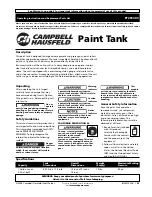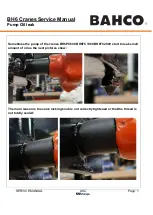
Assembly (Continued)
EQUIPMENT USE
TO USE A SPRAY GUN
1. Attach the air supply hose (not
Included) to the 1/4 NPT T Fitting.
2. Attach an air hose between the
opposite side of the T Fitting and
the spray gun air inlet.
NOTE:
A 15 ft. air hose and 15 ft.
material hose between the paint tank
and spray gun is recommended. Up to
25 ft. of air hose may be used between
the paint tank and the compressor. A
longer length may create a large
pressure drop.
3. Attach a material hose between the
paint tank connection and the spray
gun material inlet.
Use of a
material
hose that is not compatible with the
solvents being used could result in
damage or serious injury.
Operation
1. Before using the tank for the first
time, the seal and bracket position
should be established by pre-
pressurizing the tank.
a. Connect the material hose to the
spray gun.
b. Connect the air hose from
regulator to the spray gun or cap.
c. Before filling the tank with paint
material, evenly tighten the
knobs so that the lid is secure and
sealed.
d. Close the paint tank regulator by
turning fully counterclockwise,
then open the air regulator on
the source to deliver air to the
paint tank regulator.
e. Increase paint tank pressure by
turning the knob clockwise until
30 psi reads on the tank regulator
gauge.
f. Check for leaks in the system. If a
fitting leaks, depressurize the
tank by shutting off the air at the
air source regulator and gently
pulling the ring on the paint tank
safety valve until air no longer
hisses from it. Tighten the leaking
fitting, then open the air source
regulator to deliver 30 psi into
the paint tank and material hose.
g. Depressurize system by shutting
off air supply, then gently pull
the relief valve ring to relieve the
pressure in the system.
2. The tank may now be filled with
material. Before filling, thoroughly
mix and strain the paint to remove
skins or undissolved particles which
might otherwise impede the flow of
material through the hose and gun.
A one gallon can of paint can be set
inside the tank instead of pouring
the paint into the tank.
Never
use this
paint tank with materials which
contain trichloroethane, chlorinated
hydrocarbons, nitrohydrocarbons,
esters, amines, or organic compounds.
These materials will damage the gasket
between the paint tank and lid. A
damaged gasket may cause injury and
will reduce the efficiency of the paint
tank.
3. Place lid on paint tank then tighten
knobs evenly and gradually.
DO NOT USE WRENCH OR PLIERS TO
TIGHTEN KNOBS. HAND TIGHTEN
ONLY (50 IN.LBS.)
4. Turn pressure off at the air source
regulator by turning
counterclockwise. Pressure gauge
should read 0 psi.
5. Shut off paint tank regulator by
running counterclockwise.
SPRAY GUN OPERATION
1. Adjust air source regulator pressure
required for spraying (usually
between 50-70 psi).
2. Adjust paint tank regulator to 25-30
psi. More pressure is needed on the
material as the gun is moved further
above the tank. Normal operating
on the paint tank is 25 to 30 psi.
When lower pressure is needed,
rotate the adjustment
counterclockwise until the desired
pressure setting is obtained. There is
no need to trigger the gun in order
to bleed off excess paint pressure.
Do not
use over
50 psi in the tank.
The sprayer may now be used to apply
paint.
CAMPBELL
HAUSFELD
Air source
regulator
Material hose
Air hose
Air hose
Material
hose
Figure 4
Paint tank
regulator
Knob
Pressure
gauge
PT281303
3
www.chpower.com
Summary of Contents for PT281303
Page 5: ...PT281303 5 www chpower com Notes...
Page 13: ...PT281303 13 Fr Notes...




































